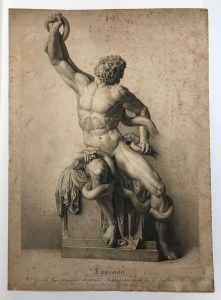
Laocoon
Engraving, c.61 x 40.2 cm (image); 64 x 45.5 cm (paper)
Presented by Thomas Alexander, Esq., by 1861
National Gallery of Victoria (p.179.1-1)
As the French inscription indicates, this image reproduces the central figure from the famous Hellenistic group in the Vatican. Subsidiary inscriptions identify Reverdin as the draughtsman and Girard as engraver (“del.” and “sculp.” respectively).
After studying drawing in Geneva, Reverdin moved to Paris in 1794 and studied with David; there is a crayon portrait of him by Ingres in Geneva (1823). Girard was active in Paris from the 1810s, producing both reproductive engravings and mezzotints. Another print by Girard shows the entire group.
The Laocoön statue, based on the story of the tragic death of the Trojan priest and his sons (also recounted in book 2 of Virgil’s Aeneid), was already known through Pliny the Elder’s 1st-century description, identifying it as the work of Agesander, Polydorus, and Athenodorus, natives of Rhodes. After its discovery in Rome in 1506, it was frequently copied and reproduced. The pre-Felton collection also included plaster casts of the whole group (at reduced scale) and a bust of the central figure: see now Casts – I.Statues etc. (I.75) and Casts – II. Busts & heads (II.71).
Both the present engraving and the pre-Felton cast were based on the restored version of the Vatican group, with the upraised arms of all three figures completed by Montorsoli and others. Modern “re-restoration” has removed these speculative additions, and incorporated the fragmentary bent arm of the central figure, discovered in the 1950s. The group is now understood to be a late Hellenistic work from Pliny’s era, probably based on a Pergamene statue (possibly in bronze) from c.200 BC.
Refs.
MPL catalogue 1861, p.lvii (Donations to the Museum of Art: as presented by Alexander; artist/s not named); AR 1870-71, p.34: Engravings (framed); not catalogued in NGV 1894 or 1905
PF (1868); the current NGV catalogue lists this as by an unknown engraver after Reverdin, 1880 (not reproduced). Author’s ID photo shown here
For Reverdin, see e.g. Memoires et Documents publies par la Societe d’Histoire at d’Archeologie de Geneve, t.16, 1849, pp.459-60: available through Google books as https://books.google.com.au/books?id=QqDBfMGiHLQC&pg=PA459&lpg=PA459&dq=Reverdin+Laocoon&source=bl&ots=B_vfvk31EN&sig=ETYL7cLtoCWeDiFWu1HuH9qmPPM&hl=en&sa=X&ved=2ahUKEwirlp6a68rfAhVIabwKHYNIDfUQ6AEwC3oECAUQAQ#v=onepage&q=Reverdin%20Laocoon&f=false. See also http://www.sikart.ch/KuenstlerInnen.aspx?id=4025979 (Lexikon zur Kunst in der Schweiz) and https://fr.wikipedia.org/wiki/François-Gédéon_Reverdin; and https://www.latribunedelart.com/le-musee-d-art-et-d-histoire-de-geneve-achete-un-dessin-d-ingres (for the Ingres portrait)
For Girard, see e.g. https://fr.wikipedia.org/wiki/Alexis-François_Girard (details as above); and for his engraving of the group, with reproduction, see e.g. https://www.alamy.com/37-alexis-franois-girard-laocoonte-image188170711.html [both sites accessed 17/8/19]. Both AKL 55 (2007), pp.167-68 and Bénézit 6, p.259, list Girard’s date of both as 1787
For an informative account of the Vatican statue, including comments on dating, interpretation and restoration, see Haskell & Penny, Taste and the Antique (1981), cat.52, pp.243-47 (and fig.125, a reproduction of the group prior to the modern restoration); see also https://en.wikipedia.org/wiki/Laoco%C3%B6n_and_His_Sons [accessed 21 March 2016], a well documented recent article, including photographs of the work in its current state, and citing various recent studies, especially Seymour Howard, “Laocoon Rerestored,” Am.J.of Archaeology 93.3 (July 1989), pp.417–422

